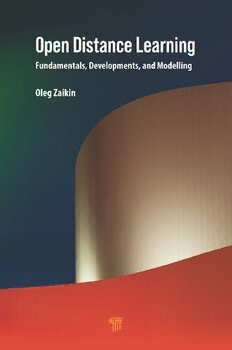Table Of ContentOpen Distance Learning
Open Distance Learning
Fundamentals, Developments, and Modelling
Oleg Zaikin
WARSAW SCHOOL
OF COMPUTER SCIENCE
Academic Series, WSCS IT and Teleinformatics
~
JENNY STANFORD
PUBLISHING
Published by
Jenny Stanford Publishing Pte. Ltd.
101 Thomson Road
#06-01, United Square
Singapore 307591
Email: [email protected]
Web: www.jennystanford.com
British Library Cataloguing‑in‑Publication Data
A catalogue record for this book is available from the British Library.
Open Distance Learning: Fundamentals, Developments, and
Modelling
Copyright © 2023 Jenny Stanford Publishing Pte. Ltd.
All rights reserved. This book, or parts thereof, may not be
reproduced in any form or by any means, electronic or
mechanical, including photocopying, recording or any
information storage and retrieval system now known or to be
invented, without written permission from the publisher.
For photocopying of material in this volume, please pay a copying
fee through the Copyright Clearance Center, Inc., 222 Rosewood
Drive, Danvers, MA 01923, USA. In this case permission to
photocopy is not required from the publisher.
ISBN 978‐981‐4877‐55‐8 (Hardcover)
ISBN 978‐1‐003‐13261‐5 (eBook)
Contents
Preface ix
Foreword xi
Acknowledgements xix
1 OpenDistanceLearning 1
1.1 TheConceptofOpenandDistanceLearning 1
1.1.1 AspectsofOpenandDistanceLearninginthe
ScaleofEuropeanUnion 3
1.1.2 AnalysisoftheOpennessIssueinDistance
LearningSystems 6
1.1.3 Conclusions 12
1.2 ManagementModelofOpenDistance
LearningSystem 13
1.2.1 Introduction 13
1.2.2 OpenandDistanceLearning 15
1.2.3 HierarchicalStructureofODL 16
1.2.4 FunctionalSchemeofOpenSystemof
DistanceLearning 25
1.2.5 Conclusion 33
1.3 StudentLifeCycle 34
1.3.1 PropositionoftheStudentLifeCycle 34
1.3.2 Conclusion 40
2 MethodsofModellingofCompetence 43
2.1 TheMeaningoftheConceptof‘Competence’ 43
2.2 StandardsofCompetence 48
2.3 CompetenceModelforProjectManagement 50
2.4 Competence‐Based Approach: Representation of the
StructureandRangeofCompetence 52
v
vi Contents
|
3 TeamProjectProcessOrientedonAcquiringCompetence 59
3.1 NewEducationalModelDevelopedforAcquiring
ProjectTeamCompetence 59
3.1.1 EngineeringintheGlobalWorld 59
3.2 ScenariooftheLearningSituation 64
3.2.1 OrientationoftheODLProcessontheActive
CooperationofStudentsandtheTeacher 64
3.2.2 StatingtheProblemofMotivationinthe
SpecificLearningSituationofODL 67
3.3 TeamProjectProcessOrientedonAcquiring
Competence 70
3.4 ModelsofCompetenceintheOpenDistanceLearning
System 74
3.4.1 TypesofCompetence 74
3.4.2 DescriptionoftheStructureofSummary
Competencies 76
3.4.3 OrganisationofCollaborationofSpecialistsin
DevelopingtheProject 78
3.4.4 Determining the Requirements for the Team
ImplementingtheSpecialty 79
3.4.5 StatementoftheTaskofSelectingCompetent
Partners 81
3.4.6 AnalysisofthePartnerEvaluationCriteria 82
3.4.7 TheProblemoftheQualityofDevelopingand
ImplementingtheTeaching–LearningProcess 84
4 OntologyModellinginOpenDistanceLearning 91
4.1 OntologyasaMethodofKnowledgeRepresentation 91
4.1.1 ClassificationofOntologies 94
4.1.2 GeneralisationofOntology:Example 96
4.1.3 MethodsofCreationandOntologyLanguages 97
4.1.4 KindsofOntologies:Examples 99
4.1.5 CriteriaforOntologyCreation 100
4.1.6 Conclusion 102
4.2 KnowledgeRepresentationinOpenDistanceLearning 103
4.2.1 KnowledgeintheTraditionalandDistance
LearningProcess 103
4.2.2 Content,VolumeandDepthofKnowledge 106
Contents vii
|
4.3 OntologicalSchemeFormationforKnowledge
DomaininODL 112
4.3.1 ConceptsNetworkCreationAlgorithm 112
4.3.2 DidacticMaterialsCompilationAlgorithm 114
4.3.3 ConceptsNetwork’sRelations 116
4.3.4 Scheme of the Concepts Network Creation
Algorithm 118
4.3.5 PropositionfortheDidacticMaterials’
CompilationAlgorithm 121
4.3.6 ConceptsNetworkDimensionReduction 122
4.3.7 Basic Concepts Selection Using the Student’s
Profile 122
4.3.8 HierarchicallyOrderedConceptsNetwork 124
4.3.9 TransformationoftheHierarchicallyOrdered
ConceptsNetwork 125
4.3.10 CreationofOverlappingPortions 126
4.3.11 Graph’sClustering 128
4.3.12 SCORMFramework 130
4.3.13 Application 131
4.3.14 Summary 133
4.4 CaseStudy1.OntologicalModelofRelational
DatabaseofIntangibleProduction 134
4.4.1 RequirementsoftheCIUStructure(3‐Normal
Form) 137
4.4.2 StructuralRelationsofInformationObjects 138
4.4.3 ExampleofRelationalDatabaseModel
Development 141
4.4.4 AComplexInformationObjectasaConnection
betweenSimpleObjects 143
4.4.5 Elimination of Redundant M:M Relations
betweenInformationObjectsintheMatrixof
Relationships 146
4.4.6 CanonicalFormoftheRelationalModel 148
4.4.7 AlgorithmofProcessingAdjacentMatrixP=
p 150
ij
(cid:30) (cid:30)
4.4.8 ExampleoftheProject“DevelopaRelational
DatabaseModelintheGivenSubjectArea” 152
4.4.9 TypicalQueriesandNeededforTheir
ImplementationofFunctionalLinks 155
viii Contents
|
4.4.10 Conclusion 159
4.5 CaseStudy2.OntologicalModeloftheObject‐
OrientedDatabase... 160
4.5.1 ProblemofCompatibilityofCompetenciesin
ProfessionalLearning 160
4.5.2 OntologicalModelofObject‐Oriented
Database 165
4.5.3 Conclusions 174
4.6 CaseStudy3:OntologicalModelofSupplyChain
Management 174
4.6.1 WhatIsSupplyChainManagement? 175
4.6.2 MathematicalModelofanEnterprise 182
4.6.3 OntologicalModelofDistributedSupplyChain
(DSC) 185
4.6.4 MathematicalProceduresofaDSCOntological
Model 191
4.7 Conclusion 196
5 MotivationModellinginOpenDistanceLearning 199
5.1 Competence‐BasedOpenDistanceLearning 199
5.1.1 Introduction 199
5.2 TheNeedforActiveCooperationofStudentsand
TeachersinODL 202
5.3 InterpretationoftheMotivationModelofLearning
Processes 205
5.4 StatementoftheMotivationProbleminaParticular
ODLSituation 208
5.4.1 BasicComponentsoftheLearningSituation 210
5.4.2 DecisionParameters 213
5.4.3 CriterionandObjectiveFunctions 213
5.5 MotivationModelInterpretationinTermsofGame
Theory 216
5.6 TheProcedurefortheAcquisitionofPersonal
Competence 221
5.6.1 TheAlgorithmAcquisitionofCompetencies 221
5.6.2 OntologicalGraphoftheCourseConsistent
withtheStructureofCompetence 225
5.7 TheLinguisticDatabaseasaToolSupportingthe
LevelofStudentMotivation 229
Contents ix
|
6 CollaborationModellinginOpenDistanceLearning 233
6.1 RepresentationofCompetenceasaClassicaland
FuzzySet 233
6.1.1 Introduction 233
6.1.2 RepresentationofCompetenceasa
ClassicalSet 234
6.1.3 RepresentationofCompetenceasaFuzzySet 236
6.1.4 ThePowerofCompetence 237
6.1.5 RelationshipandBasicCompetence 237
6.1.6 PotentialforCompetence 237
6.1.7 TheCriticalLevelofPotentialforCompetence 238
6.2 TeamCollaborationModelandMethodofAnalysisof
theCostExtendingCompetence 243
6.2.1 MethodsofAnalysisoftheCostofExpanding
SetofCompetencies 243
6.2.2 TeamCollaborationModelandCompetence
Expansion Algorithm to Perform the Project
Task 245
6.2.3 CaseStudy 250
6.2.4 Summary 255
6.3 CostEstimationAlgorithmandDecision‐Making
ModelforCurriculumModificationinEducational
Organisation 256
6.4 ConceptualisationoftheCurriculumModification
DecisionModel 257
6.5 FunctionalSchemaofEducationalOrganisation 258
6.6 ModeloftheDecisionSupportSystemforCurriculum
Modification 265
6.6.1 CompetenceRepresentationModel 267
6.6.2 GroupCompetenceExpansionAlgorithm 270
6.7 CaseStudy 273
6.7.1 PreliminaryExpansionPhase 280
6.7.2 MainExpansionPhase 283
6.8 Summary 287
7 IncentiveModelofaProjectLearningProcess 289
7.1 Introduction 289
7.2 StatingtheIncentiveProbleminaSpecificEducation
Situation 291

